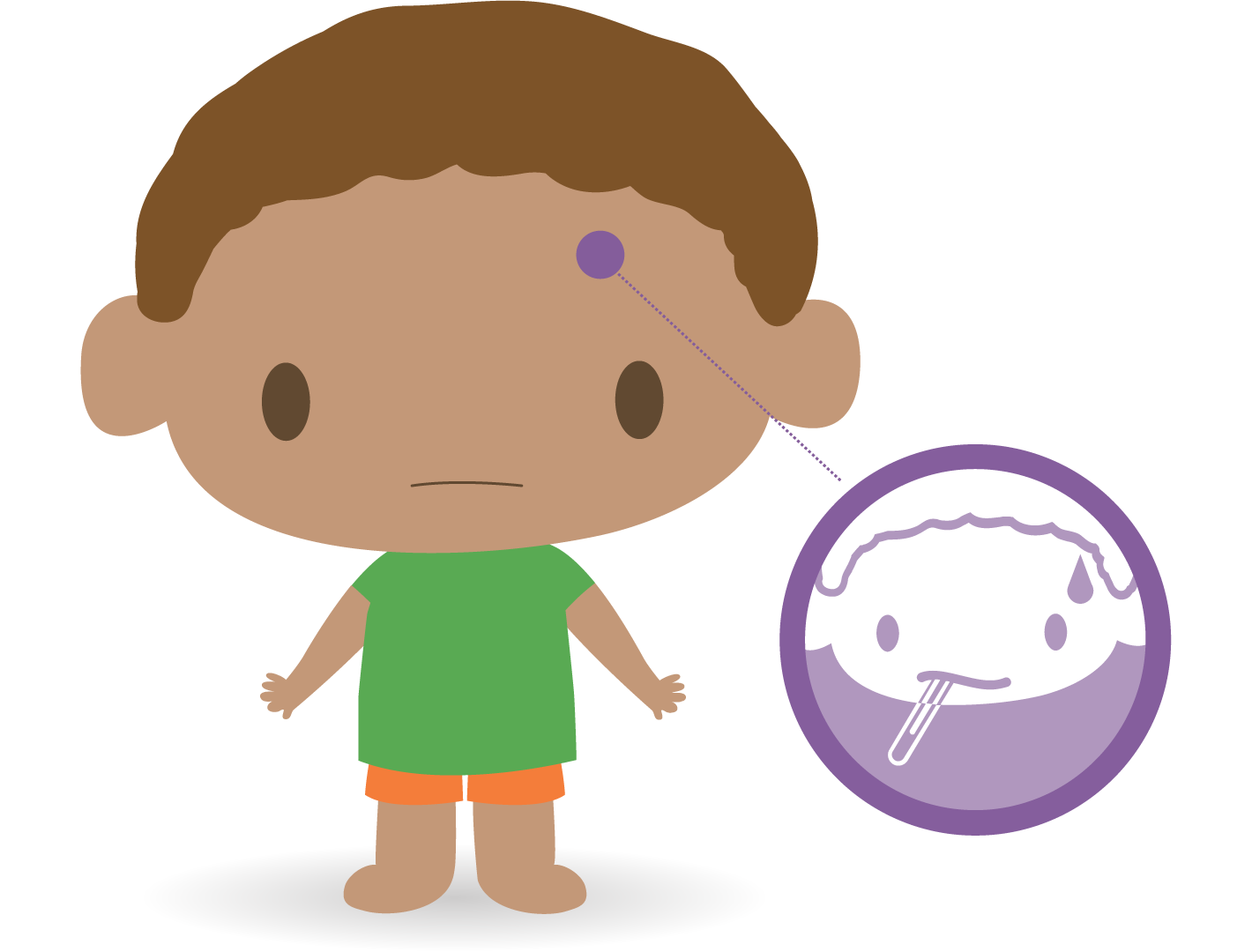Fever in Children
HEAL

This information has been translated into other languages – see the links at the bottom of this page.
Key Points
- Fevers are very common in children and are a sign that their body is fighting an infection.
- Viral infections are the most common cause of fevers in children.
- Fever itself will not harm your child – more important is how your child is behaving while unwell.
- Fevers caused by common viral infections usually last 3 to 5 days.
What Is It?
- Fever is one way your child’s body fights an infection. The most common illness in children is infection from a virus. There are thousands of different viruses. Fever can also be caused by an infection with bacteria.
- Fever itself will not harm your child.
- How high your child’s temperature is does not tell you how serious your child’s illness is. How your child is behaving is a more important sign.
Measuring Your Child's Temperature
Converting Celsius to Fahrenheit
| Celsius (°C) | Fahrenheit (°F) |
| 36.0 | 96.8 |
| 37.0 | 98.6 |
| 37.5 | 99.5 |
| 38.0 | 100.4 |
| 39.0 | 102.2 |
| 40.0 | 104.0 |
| 41.0 | 105.8 |
Normal temperatures
Normal temperatures in children depend on the type of thermometer and where the temperature is taken. Normal temperatures are (according to the Canadian Paediatric Society):
- Rectal (bum): 36.6 to 38.0°C (97.9 to 100.4°F)
- Mouth: 35.5 to 37.5°C (95.9 to 99.5°F)
- Underarm (armpit): 36.5 to 37.5°C (97.7 to 99.5°F)
- Ear (not recommended in infants): 35.8 to 38.0°C (96.4 to 100.4°F)
Children often feel warm to the touch when they have a fever. To confirm that your child has a fever, use a thermometer to measure your child’s body temperature. If your child’s temperature is higher than normal, they have a fever.
Symptoms
- Fevers can make children feel uncomfortable. Usually, these symptoms are mild and the child may be slightly cranky or have aches and pains. Some children are less active and sleepier.
- Some fevers are associated with shaking (chills or rigors). This is a way for the body to try to manage its temperature. Chills and rigors should not change your child’s level of alertness and is not considered a seizure.
- In children, fevers tend to appear in the afternoon and evenings.
- How often the fever occurs and how long it lasts depends mostly on the type of infection causing the fever. Most fevers caused by viruses last for 3 to 5 days but sometimes can last longer.
Treatment
Fevers are a sign that your child’s body is fighting an infection. The best way to treat your child is to keep them hydrated and comfortable. Most children will get better on their own in 3 to 5 days.
Fluids
- Many children will be less hungry when they are sick and not interested in eating. It’s ok if your child eats less solid foods for a few days.
- Make sure your child stays hydrated by encouraging them to drink small sips of fluids throughout the day (water, milk, soup, yogurt, popsicles or Pedialyte).
- Monitor your child for signs of dehydration.
Acetaminophen and ibuprofen
- Fevers help the body fight an infection and do not need to be treated all the time. If your child seems uncomfortable, you can give them acetaminophen or ibuprofen.
- Here are examples of different preparations for children. Follow the dosing instructions on the packaging or as advised by a health care professional.
| Acetaminophen (Tylenol, Tempra) | Ibuprofen (Motrin, Advil) |
| Infants | - Drops 80mg/1mL
- Liquid 80mg/5mL
| Drops 40mg/mL |
| Children | - Liquid 160mg/5mL
- Chewable tablets 80mg/tablet
| - Liquid 100mg/5mL
- Chewable tablets 50mg/tablet
|
| Junior Strength | - Chewable 160mg/tablet
- Regular tablets 325mg/tablet
- Extra strength tablets 500mg/tablet
| - Chewable tablets 100mg/tablet
- Caplets 100mg/tablet
- Tablets 200mg/tablet
- Tablets 400mg/tablet
|
| How Often? | Can give every 4 hours, but no more than 5 doses in 24 hours | Can give every 6 hours but no more than 4 doses in 24 hours |
| Do Not Use If Your Child… | Has known liver disease or decreased liver function | - Is less than 6 months old
- Appears moderately dehydrated
- Has known decreased kidney function
- Has asthma and is known to have a sensitivity to aspirin
|
Beware
- Products with aspirin (ASA) in them should not be given to children because of the risk of developing a serious illness called Reye’s syndrome.
- Cough, cold, and sinus products have other medicines added. These products are usually not recommended or needed.
Bathing
- Having a bath may make your child feel more comfortable, but it does not change their body temperature. Try a lukewarm bath or wet face cloths.
- Avoid cold baths because they are uncomfortable and can make your child shiver, raising their temperature.
- Alcohol baths or rubs are not recommended.
Clothing
- Losing heat through the skin allows the body to cool down and may make your child feel more comfortable.
- Dress your child in light clothing. If your child starts to shiver, add warmer clothing. Remove the warmer clothing when the shivering stops.
Fevers Myths
Myth #1: Fevers cause brain damage.
- Most fevers are less than 42°C (108°F) and do not cause brain damage. The body temperature needs to be much higher to cause damage, and this is more likely to occur with heat stroke or after exposure to drugs or medicines rather than typical childhood infections.
Myth #2: Fevers are bad for children.
- A fever is a sign that the body’s defense system has been activated. Raising the body temperature may help the body fight an infection.
- The main reason to use medicines like acetaminophen or ibuprofen is to help keep your child comfortable.
Myth #3: Fevers should always respond to anti-fever medicines.
- Anti-fever medicines usually help to bring fevers down, but this is not always the case.
- Whether or not the medicine works to reduce the fever back to a normal temperature is not related to the seriousness of the infection.
When To Get Help
Call 911 anytime you think your child may need emergency care.
Seek immediate medical attention if:
- Your child is less than 3 months old with a fever.
- Your child looks ill even after fever medicine has been given (very sleepy, confused, irritable, or agitated).
- Your child is having trouble breathing.
- Your child is severely dehydrated.
- Your child is complaining of headaches, neck pain or stiffness, or light sensitivity.
- Your child has a bruise-like rash on their body.
Know your options
It can be scary when your child is sick. But in most cases, you don’t need to go to the emergency department. If you’re unsure, visit ahs.ca/options to learn about the options so you can get the care you need.
About AHS HEAL
The Alberta Health Services HEAL (Health Education and Learning) program was created by a team of doctors, nurses, and other clinical staff who work at the Alberta Children’s Hospital and the Stollery Children’s Hospital, to support families and patients with up-to-date and useful information about common childhood health concerns. Learn more at ahs.ca/heal.
To see this information online and learn more, visit: ahs.ca/heal/page12428.aspx

Related to Fever in children:
Other languages
Fever in children: HEAL
For 24/7 nurse advice and general health information call Health Link at 811.
Current as of: November 13, 2024
Author: Pediatric Emergency Medicine, Alberta Health Services
This material is not a substitute for the advice of a qualified health professional. This material is intended for general information only and is provided on an "as is", "where is" basis. Although reasonable efforts were made to confirm the accuracy of the information, Alberta Health Services does not make any representation or warranty, express, implied or statutory, as to the accuracy, reliability, completeness, applicability or fitness for a particular purpose of such information. Alberta Health Services expressly disclaims all liability for the use of these materials, and for any claims, actions, demands or suits arising from such use.
